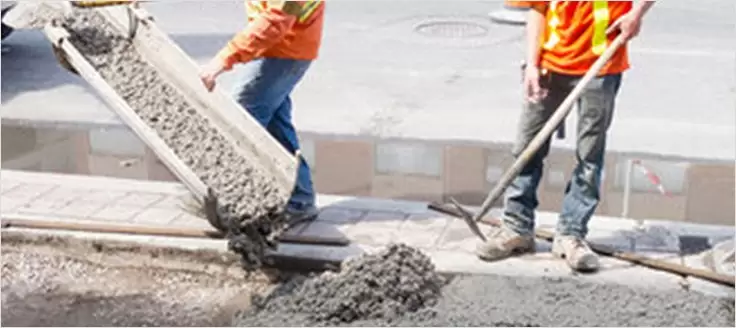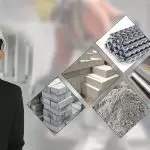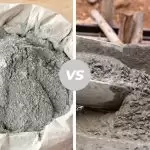What is PPC Cement & OPC Cement?
PPC Cement: Pozzolana is a natural or artificial material which contains silica in the reactive form. Portland Pozzolana Cement is cement manufactured by combining Pozzolanic materials. This cement comprises OPC clinker, gypsum and pozzolanic materials in certain proportions. The Pozzolanic materials include fly ash, volcanic ash, calcined clay or silica fumes. These materials are added within a range of 15% to 35% by cement weight.
Post your Requirement
OPC Cement: OPC cement or Ordinary Portland Cement (OPC) is manufactured by grinding a mixture of limestone and other raw materials like argillaceous, calcareous, and gypsum to a powder. This cement is available in three types of grades, such as OPC 33 grade, OPC 43 grade and OPC 53 grade. OPC is the most commonly used cement in the world. This type of cement is preferred where a fast pace of construction is done. However, the making of OPC has reduced to a great extent as blended cement like PPC has advantages, such as lower environmental pollution, energy consumption and more economical.
Difference Between OPC And PPC Cement
The main differences in their characteristics and uses are –
- Portland Pozzolana Cement is a variation of Ordinary Portland Cement. Pozzolana materials namely fly ash, and volcanic ash, are added to the OPC so that it becomes PPC. Pozzolana materials are added to the cement in the ratio of 15% to 35% by weight.
- Both are eco-friendly materials but Pozzolana Cement uses natural and industrial waste thus reducing environmental pollution.
| OPC | PPC |
|---|---|
| It has a higher strength than PPC in the initial stage. | The strength of PPC is better than OPC in the long term. |
| It has a high heat of hydration making it unfavourable for mass concreting. | The hydration process is slower than OPC resulting in low heat of hydration. Therefore, it is suitable for mass concreting. |
| The presence of sulphates, alkalies, chlorides, etc. is higher and less resistant than PPC. | It has a low percentage of sulphate alkalis, chlorides, magnesia and free lime in its composition, which makes the concrete durable. |
| OPC is not favourable in aggressive weather. | Show greater resistance to aggressive weather. |
| OPC cement is available in three grades, such as 33 Grade, 43 Grade, and 53 Grade | PPC is available in any specific grade. |
| It is slightly costlier than PPC. | Cheaper than OPC. |
Conclusion: Both OPC and PPC are commonly used cements in construction. These days, PPC is used as a substitute for OPC. PPC is a variation of OPC which adds a mixture of a pozzolanic material that helps to enhance the strength of the concrete. PPC also brings down the amount of OPC requirement in making concrete. Interestingly, it is a green material that contributes towards sustainable development. Considering these factors, PPC has a slight edge over OPC. However, it is difficult to come to a definite conclusion.
Related Article: What is Portland Pozzolana Cement?
OPC And PPC Grade
As per the classification of the Bureau of Indian Standards (BIS), OPC comes in three different grades, including 33 grade, 43 grade and 53 grade. Due to weak compressive strength, 33 grade is normally not opted where a high grade of concrete viz, M-20 and above is required. 43 grade is widely used for its multiple applications. This grade is very popular in the construction industry. 53 grade has a high strength that can match the demand for strong concrete. However, the chemical composition of OPC 33, OPC 43 and OPC 53 grades is the same though the higher grade cements are much stronger and long-lasting. Whereas the compressive strength of PPC matches the strength of 33-grade OPC at present, according to BIS.
What Is The Difference Between Grade 43 And Grade 53 Cement?
Grade 43 and grade 53 cement indicate the maximum strength achieved after 28 days. These are the most commonly used grades of cement and the differences between the two grades of cement are –
- Grade 53 cement achieves a strength of 530kg/sq. cm. after 28 days while Grade 43 cement achieves a strength of 430kg/sq. cm. after 28 days.
- Grade 53 cement is used for fast-paced construction like bridges, roads, multistoried buildings and cold weather concrete. Grade 43 cement is used as the most widely used general-purpose cement.
- Grade 53 cement has a very quick setting time and attains quick strength. The strength does not increase much after 28 days. Grade 43 cement has a low initial strength but gains good strength over a period of time.
- Grade 53 Cement sets fast and releases higher heat of hydration while Grade 43 Cement releases very low heat of hydration. As a result, there are chances of micro-cracks which are not visible on the surface in Grade 53 Cement and proper curing should be done.
- Grade 53 cement is slightly costlier than Grade 43 Cement.
Use Of PPC And OPC
PPC is believed to be a future product considering its various applications in the construction industry. They are suitable for use in hostile environmental conditions. They can be reliably utilized in the construction of marine structures, masonry mortars and plastering, and hydraulic structures. Besides, they are popularly used in mass concreting works, such as dykes, sewage pipes, dams, etc. PPC is also employed in all other applications where OPC is used. However, OPC is the most commonly used cement worldwide. The cost of production is not expensive making it the sought-after cement in the building industry. They are widely used for the construction of high-rise buildings, roads, dams, bridges, and flyovers. Also, OPC is used for making grouts and mortars. OPC is ideal for the construction of residential and industrial complexes.

PPC VS. OPC Cement























Post A Comment